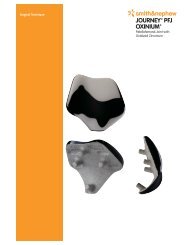Uni- Condylar Knee Surgical Technique - Yorkshire Joint ...
Uni- Condylar Knee Surgical Technique - Yorkshire Joint ...
Uni- Condylar Knee Surgical Technique - Yorkshire Joint ...
Create successful ePaper yourself
Turn your PDF publications into a flip-book with our unique Google optimized e-Paper software.
Balancing<br />
Goal: Determine amount of femoral distal<br />
resection and tibial insert thickness, to<br />
achieve equal extension and flexion gaps.<br />
Figure 17<br />
Check the flexion and extension gaps<br />
using the tibial trial of the desired size<br />
and thickness. Use the D-shaped end as<br />
the “spacer block”. The D-shaped end has<br />
the same dimensions as the tibial implants.<br />
(The opposite end is used to introduce the<br />
Metal-Backed Tibial Tray into the joint space<br />
during cementing.) Composite thicknesses of<br />
the metal-backed tray and insert are 7 mm<br />
to 11 mm in one millimetre increments.<br />
All-polyethylene insert thicknesses are 8 mm<br />
to 11 mm in one millimetre increments.<br />
Flexion Gap Evaluation<br />
Flex the knee to 90° and check the flexion gap<br />
using the tibial trial of the desired thickness<br />
(Figure 17). If the flexion gap is tight, use caution<br />
before consideration of additional tibial resection.<br />
Evaluate the slope to ensure lack of slope is not<br />
contributing to a tight flexion gap. Do not resect<br />
additional tibial bone unless the extension<br />
space is also tight.<br />
Extension Gap Evaluation<br />
Place the knee in extension and assess the<br />
extension gap with the tibial trial (Figure 18). The<br />
extension gap can be filled 1, 2 or 3 mm distally<br />
with use of a femoral defect shim. If extension<br />
laxity exists relative to flexion, use a thicker trial in<br />
extension to get an idea of which femoral defect<br />
shim should be used.<br />
If both the femoral and tibial gaps are loose, a<br />
thicker tibial component should be used.<br />
Figure 18<br />
At this stage the tibial implant thickness,<br />
extension gap, stability of the collateral ligaments,<br />
limb alignment and ability to achieve full<br />
extension can be verified.<br />
10





